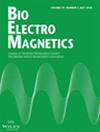Nathan Bala, Rodney J. Croft, Robert L. McIntosh, Steve Iskra, John V. Frankland, Raymond J. McKenzie, Chao Deng
下载PDF
{"title":"自由运动大鼠对1.95 GHz电磁场的核心温度响应特性","authors":"Nathan Bala, Rodney J. Croft, Robert L. McIntosh, Steve Iskra, John V. Frankland, Raymond J. McKenzie, Chao Deng","doi":"10.1002/bem.70013","DOIUrl":null,"url":null,"abstract":"<p>The present study investigated the core body temperature (CBT) response of free-moving adult male and female Sprague Dawley rats, during and following a 3-h exposure to 1.95 GHz radiofrequency electromagnetic fields (RF-EMFs) within custom-built reverberation chambers, using temperature capsules implanted within the intraperitoneal cavity and data transmitted via radiotelemetry. Comparing RF-EMF exposures (at Whole-Body Average-Specific Absorption Rate [WBA-SAR] levels of 0.1, 0.4, and 4 W/kg) to the sham exposed condition, we identified a statistically significant peak increase in CBT after 26 min of RF-EMF exposure at 4 W/kg (+0.49°C), but not in the 0.1 or 0.4 W/kg conditions at the same timepoint. In the last 30 min of the RF-EMF exposure, temperature was significantly increased in both the 4 W/kg (0.62°C) and 0.4 W/kg (0.14°C) conditions, but not 0.1 W/kg, when compared to sham. After 20 min following cessation of exposure, post temperature was still significantly higher in the 4 W/kg condition when compared to the sham (0.37°C), but not in either 0.1 or 0.4 W/kg. Based on our findings, it is apparent that rats can effectively compensate for increased thermal loads of up to 4 W/kg as the maximum temperature rise was substantially lower than 1°C. In addition, the elevated CBT during exposure in the 4 W/kg condition was significantly reduced immediately after exposure cessation, indicating that measures of CBT following RF-EMF exposure cessation may not reflect maximum RF-EMF-mediated changes in the CBT of rats. Bioelectromagnetics. 00:00–00, 2025. © 2025 Bioelectromagnetics Society.</p>","PeriodicalId":8956,"journal":{"name":"Bioelectromagnetics","volume":"46 5","pages":""},"PeriodicalIF":1.2000,"publicationDate":"2025-06-26","publicationTypes":"Journal Article","fieldsOfStudy":null,"isOpenAccess":false,"openAccessPdf":"https://onlinelibrary.wiley.com/doi/epdf/10.1002/bem.70013","citationCount":"0","resultStr":"{\"title\":\"Characterization of the Core Temperature Response of Free-Moving Rats to 1.95 GHz Electromagnetic Fields\",\"authors\":\"Nathan Bala, Rodney J. Croft, Robert L. McIntosh, Steve Iskra, John V. Frankland, Raymond J. McKenzie, Chao Deng\",\"doi\":\"10.1002/bem.70013\",\"DOIUrl\":null,\"url\":null,\"abstract\":\"<p>The present study investigated the core body temperature (CBT) response of free-moving adult male and female Sprague Dawley rats, during and following a 3-h exposure to 1.95 GHz radiofrequency electromagnetic fields (RF-EMFs) within custom-built reverberation chambers, using temperature capsules implanted within the intraperitoneal cavity and data transmitted via radiotelemetry. Comparing RF-EMF exposures (at Whole-Body Average-Specific Absorption Rate [WBA-SAR] levels of 0.1, 0.4, and 4 W/kg) to the sham exposed condition, we identified a statistically significant peak increase in CBT after 26 min of RF-EMF exposure at 4 W/kg (+0.49°C), but not in the 0.1 or 0.4 W/kg conditions at the same timepoint. In the last 30 min of the RF-EMF exposure, temperature was significantly increased in both the 4 W/kg (0.62°C) and 0.4 W/kg (0.14°C) conditions, but not 0.1 W/kg, when compared to sham. After 20 min following cessation of exposure, post temperature was still significantly higher in the 4 W/kg condition when compared to the sham (0.37°C), but not in either 0.1 or 0.4 W/kg. Based on our findings, it is apparent that rats can effectively compensate for increased thermal loads of up to 4 W/kg as the maximum temperature rise was substantially lower than 1°C. In addition, the elevated CBT during exposure in the 4 W/kg condition was significantly reduced immediately after exposure cessation, indicating that measures of CBT following RF-EMF exposure cessation may not reflect maximum RF-EMF-mediated changes in the CBT of rats. Bioelectromagnetics. 00:00–00, 2025. © 2025 Bioelectromagnetics Society.</p>\",\"PeriodicalId\":8956,\"journal\":{\"name\":\"Bioelectromagnetics\",\"volume\":\"46 5\",\"pages\":\"\"},\"PeriodicalIF\":1.2000,\"publicationDate\":\"2025-06-26\",\"publicationTypes\":\"Journal Article\",\"fieldsOfStudy\":null,\"isOpenAccess\":false,\"openAccessPdf\":\"https://onlinelibrary.wiley.com/doi/epdf/10.1002/bem.70013\",\"citationCount\":\"0\",\"resultStr\":null,\"platform\":\"Semanticscholar\",\"paperid\":null,\"PeriodicalName\":\"Bioelectromagnetics\",\"FirstCategoryId\":\"99\",\"ListUrlMain\":\"https://onlinelibrary.wiley.com/doi/10.1002/bem.70013\",\"RegionNum\":3,\"RegionCategory\":\"生物学\",\"ArticlePicture\":[],\"TitleCN\":null,\"AbstractTextCN\":null,\"PMCID\":null,\"EPubDate\":\"\",\"PubModel\":\"\",\"JCR\":\"Q3\",\"JCRName\":\"BIOLOGY\",\"Score\":null,\"Total\":0}","platform":"Semanticscholar","paperid":null,"PeriodicalName":"Bioelectromagnetics","FirstCategoryId":"99","ListUrlMain":"https://onlinelibrary.wiley.com/doi/10.1002/bem.70013","RegionNum":3,"RegionCategory":"生物学","ArticlePicture":[],"TitleCN":null,"AbstractTextCN":null,"PMCID":null,"EPubDate":"","PubModel":"","JCR":"Q3","JCRName":"BIOLOGY","Score":null,"Total":0}
引用次数: 0
引用
批量引用


 求助内容:
求助内容: 应助结果提醒方式:
应助结果提醒方式:


